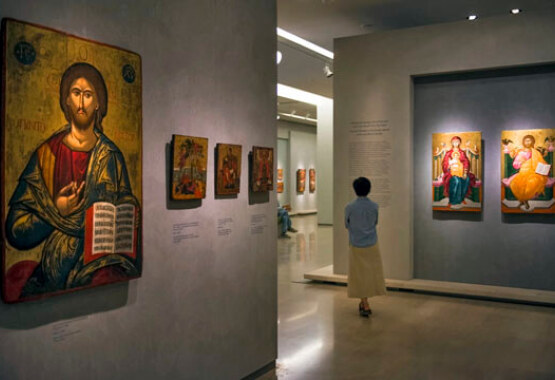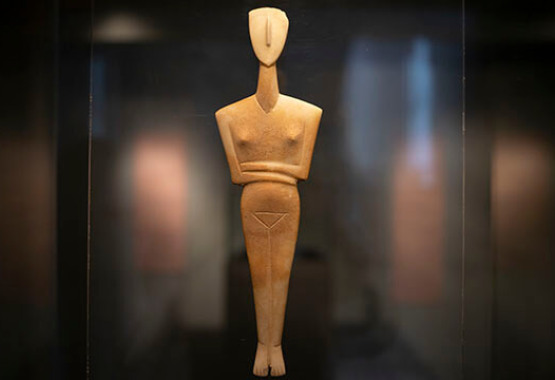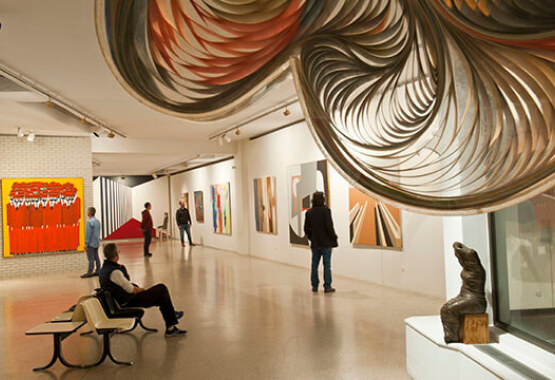
ATHENS
Contemporary Greek art has grown and evolved alongside the modern Greek state, and it has managed to reach maturity within a few decades. Many Greek artists have outshone their European masters and their creations have earned their rightful place in the global history of art.
So, follow us on a tour of the National Gallery’s most important works of art.
Right past the Gallery’s front entrance you will see the “Street Market” (1979 – 1982) by Panayiotis Tetsis, an impressive painting oozing the joy of life and creation through an explosion of colour; it’s a universal theme that relates to everyone. The “Street Market” is a masterpiece, charming, and full of life; it is a triptych, the length of which exceeds 15 metres, and its position at the entrance conveys a welcome message to all of the Gallery’s visitors, comparing it with the openness of a street market to all.
On the first floor, you will visit 19th c. Greek paintings that are representative of the so-called mature bourgeois portraiture, which develops after the dethronement of King Otto (1862). You will see splendid portraits of members of the upper-class, which was established in Greek society in the last quarter of the century [during Charilaos Trikoupis premiership]. You will be impressed by magnificent and sizeable works of art, such as the “Portrait of Mrs Serpieri”, the “Athenian Evening”, the painting titled “On the Terrace” by Iakovos Rizos, and the portrait of architect Lysandros Kaftantzoglou. You will also see paintings of N. Lytras, G. Iakovidis, N. Gyzis, P. Pantazis and other members of the so-called School of Munich. You will enjoy other art styles too, such as landscape and genre painting, orientalist art, still life paintings, early impressionist creations, symbolism and art nouveau paintings.
The yet more impressive second floor hall is where you will be ushered into the 20th c. modern Greek art. You will see the creations of Yannis Moralis, such as the 1982 “Love Scene”, those of Parthenis and other representative artists of the ‘30s, you will enjoy the paintings and engravings of D. Galanis, works of expressionist art and similar movements, creations of abstract art and those of the group “Art” (1917 – 1919) related to the early Greek modernism. Niκos Hadjikyriakos – Ghika’s cubist artwork is on display in a separate room, dedicated to the artist.
Your journey through the modern Greek art will only be complete if you visit the Gallery’s third floor, where you will see artwork related to newer styles and forms of art, such as the relation of art and technology, Figurative Art, Pop-Art, and the connection between reality and transcendence.
The Gallery’s permanent display comprises 1,000 paintings out of a total of 20,000 acquisitions.
In the premises there are well-equipped spaces, such as conservation studios where art restorers use the latest technology and tools, administration offices, and a library which expands in two floors. There are also two café – restaurants (currently under refurbishment & closed to visitors), the second one is located on the building’s last level, offering a panoramic view of the Acropolis, Lycabettus Hill, and the Saronic Gulf.
National Gallery - Alexandros Soutsos Museum
The best way to get acquainted with Greek Art, and see how it evolved from the post-Byzantine times to the present day, is to pay a visit to the National Gallery – Alexandros Soutsos Museum in downtown Athens. You’re invited to view works of art by Greek and foreign artists in this newly refurbished modern Art Museum, which highlights many aspects of Greek art and culture, and aims at attracting locals and foreign visitors alike.Contemporary Greek art has grown and evolved alongside the modern Greek state, and it has managed to reach maturity within a few decades. Many Greek artists have outshone their European masters and their creations have earned their rightful place in the global history of art.
So, follow us on a tour of the National Gallery’s most important works of art.
The National Gallery’s permanent display
The Gallery covers an area of 20,760 m2 with spacious halls and glass-fronted exterior walls, large rooms where temporary exhibitions are on display, and a digital info desk at the lobby area. Other very important indoor areas include the Library and Archive, the conservation studios such as the one for paintings on canvas and wooden panels, and the paper conservation studio. One thousand works of art make up the permanent display, drawn from the Gallery’s treasure pool of artwork.Right past the Gallery’s front entrance you will see the “Street Market” (1979 – 1982) by Panayiotis Tetsis, an impressive painting oozing the joy of life and creation through an explosion of colour; it’s a universal theme that relates to everyone. The “Street Market” is a masterpiece, charming, and full of life; it is a triptych, the length of which exceeds 15 metres, and its position at the entrance conveys a welcome message to all of the Gallery’s visitors, comparing it with the openness of a street market to all.
On the first floor, you will visit 19th c. Greek paintings that are representative of the so-called mature bourgeois portraiture, which develops after the dethronement of King Otto (1862). You will see splendid portraits of members of the upper-class, which was established in Greek society in the last quarter of the century [during Charilaos Trikoupis premiership]. You will be impressed by magnificent and sizeable works of art, such as the “Portrait of Mrs Serpieri”, the “Athenian Evening”, the painting titled “On the Terrace” by Iakovos Rizos, and the portrait of architect Lysandros Kaftantzoglou. You will also see paintings of N. Lytras, G. Iakovidis, N. Gyzis, P. Pantazis and other members of the so-called School of Munich. You will enjoy other art styles too, such as landscape and genre painting, orientalist art, still life paintings, early impressionist creations, symbolism and art nouveau paintings.
The yet more impressive second floor hall is where you will be ushered into the 20th c. modern Greek art. You will see the creations of Yannis Moralis, such as the 1982 “Love Scene”, those of Parthenis and other representative artists of the ‘30s, you will enjoy the paintings and engravings of D. Galanis, works of expressionist art and similar movements, creations of abstract art and those of the group “Art” (1917 – 1919) related to the early Greek modernism. Niκos Hadjikyriakos – Ghika’s cubist artwork is on display in a separate room, dedicated to the artist.
Your journey through the modern Greek art will only be complete if you visit the Gallery’s third floor, where you will see artwork related to newer styles and forms of art, such as the relation of art and technology, Figurative Art, Pop-Art, and the connection between reality and transcendence.
The Gallery’s permanent display comprises 1,000 paintings out of a total of 20,000 acquisitions.
In the premises there are well-equipped spaces, such as conservation studios where art restorers use the latest technology and tools, administration offices, and a library which expands in two floors. There are also two café – restaurants (currently under refurbishment & closed to visitors), the second one is located on the building’s last level, offering a panoramic view of the Acropolis, Lycabettus Hill, and the Saronic Gulf.





